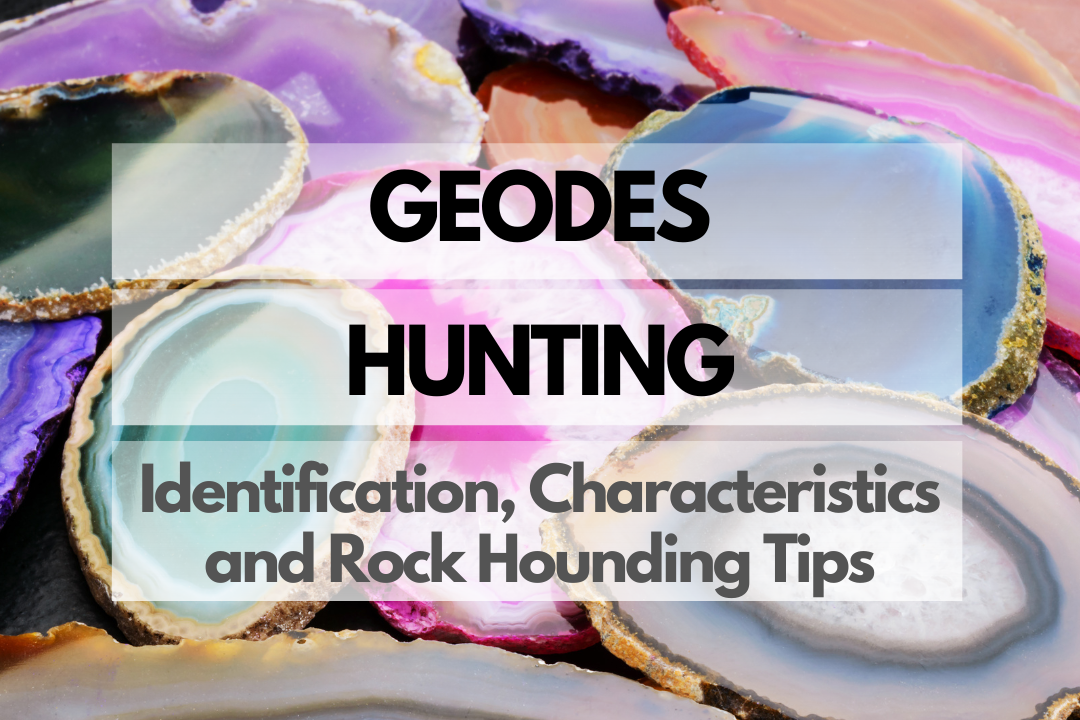Geode hunting is an exciting and intriguing pursuit for rock hounds and nature enthusiasts alike. These hollow, spherical rocks hold a treasure trove of beautiful crystals, making the thrill of discovery unlike any other. Read on to learn more about the history, identification, and characteristics of geodes, as well as tips for your geode hunting adventure.
History & Origin of Geodes
Geodes have captivated humans for centuries, with their mysterious, hidden beauty and unique formation process. The term “geode” comes from the Greek word “geoides,” which means “earth-like” or “earth-shaped.” Geodes form in various geological settings, such as volcanic rock or sedimentary formations. They often originate from gas bubbles in volcanic or sedimentary rock, which later fill with mineral-rich fluids that deposit crystals over time. Different cultures have attributed various symbolic meanings to geodes, including protection, spiritual growth, and the ability to see beyond the surface.
Geode Identification & Physical Properties
Identifying geodes can be challenging, as they often resemble ordinary rocks from the outside. However, some physical properties can help distinguish geodes from other rocks. The table below provides an overview of the key physical properties of geodes:
| Property | Description |
|---|---|
| Shape | Round or oval, often with a bumpy or irregular surface |
| Weight | Lighter than a solid rock of the same size due to the hollow interior |
| Texture | Outer shell is often rough, with a crystalline interior |
| Sound | When tapped, produces a hollow sound due to the empty cavity |
Geode Colors
Geodes can exhibit a wide range of colors, depending on the minerals present within the cavity. Common colors include white, clear, blue, purple, and brown. The color of the crystals inside a geode can help identify the specific mineral composition. For example, purple or blue crystals often indicate the presence of amethyst or quartz, while green crystals may be indicative of agate or calcite.
Geode Hardness
The hardness of a geode’s outer shell can vary, but it is typically composed of a relatively hard material such as chalcedony, which has a Mohs hardness of around 7. The crystals inside the geode can also vary in hardness, depending on the specific mineral composition. For example, quartz has a Mohs hardness of 7, while calcite has a hardness of 3.
Geode Types
Geodes can contain a variety of different minerals and crystal formations, resulting in various types of geodes. Some of the most common types include:
Quartz Geodes
Quartz geodes are among the most common types of geodes and are characterized by their beautiful, clear or white quartz crystals. These geodes can be found in many locations around the world, including Brazil, Uruguay, and the United States.
Amethyst Geodes
Amethyst geodes contain purple amethyst crystals, which are a variety of quartz. They are highly sought after for their stunning appearance and are often found in countries such as Brazil, Uruguay, and Mexico.
Calcite Geodes
Calcite geodes are characterized by their white, yellow, or orange calcite crystals. These geodes are less common than quartz or amethyst geodes and can be found in countries such as the United States, Mexico, and Morocco.
Agate Geodes
Agate geodes are characterized by their colorful, banded agate lining the interior of the cavity. These geodes are often found in countries such as Brazil, Argentina, and the United States.
Geode Uses
Geodes have a variety of uses, including:
- Home decor: Geodes make beautiful, unique decorative pieces for the home.
- Jewelry: Geode slices and crystal fragments can be used in jewelry making.
- Educational tools: Geodes can be used to teach about geology, mineralogy, and crystal formation.
- Meditation and healing: Some people believe that geodes have metaphysical properties and can aid in meditation and energy healing practices.
- Collecting: Geodes are popular among rock collectors due to their unique beauty and variety.
How Much Is a Geode Worth?
The value of a geode can vary greatly depending on its size, crystal quality, mineral composition, and rarity. Small, common geodes can be found for just a few dollars, while larger, high-quality specimens with rare minerals can be worth hundreds or even thousands of dollars. Ultimately, the worth of a geode is determined by the individual collector’s preferences and the specific qualities of the geode in question.
Geode Rock Hounding Tips
Geode hunting can be a thrilling and rewarding experience, but it’s important to be prepared and know what to expect. In this section, we’ll cover essential tips and tricks to help ensure a successful geode hunting adventure.
Essential Tools and Equipment
Having the right tools and equipment can make all the difference when hunting for geodes. Here are some essentials to consider:
- Rock hammer: A durable rock hammer is crucial for cracking open geodes and extracting them from the surrounding rock.
- Chisel: A chisel can be used to carefully split geodes along natural fractures, preserving the valuable crystals inside.
- Safety goggles: Protect your eyes from flying rock fragments by wearing safety goggles.
- Gloves: Sturdy gloves will help protect your hands from sharp rocks and offer a better grip on your tools.
- Backpack or container: A sturdy backpack or container is essential for carrying your tools and collected geodes.
- Field guide: A field guide can help you identify geodes and other interesting rocks and minerals you may encounter.
Safety Tips
Geode hunting can be an enjoyable outdoor activity, but it’s important to prioritize safety. Keep these safety tips in mind:
- Always wear appropriate safety gear, including goggles, gloves, and sturdy shoes or boots.
- Be aware of your surroundings and watch out for potential hazards, such as falling rocks or slippery surfaces.
- Stay hydrated and bring plenty of water, especially if you’re hunting in a remote area or during hot weather.
- Let someone know your planned route and expected return time, in case of emergencies.
- Make sure to pack a first aid kit, just in case of any accidents.
Geode Hunting: Where to Find Geodes
Geodes can be found in various locations around the world, often in volcanic or sedimentary rock formations. Some of the best places to find geodes include deserts, dry lake beds, and areas with a history of volcanic activity. The table below provides more specific information on where you can find geodes in different countries:
| Site/Area | Location |
|---|---|
| Hauser Geode Beds | Wiley’s Well, California, USA |
| The Dugway Geode Beds | Juab County, Utah, USA |
| Keokuk Geode Region | Iowa, Illinois, and Missouri, USA |
| Artigas | Uruguay |
| Wanda Mines | Misiones, Argentina |
| Las Choyas Geode Mine | Chihuahua, Mexico |
Caring For Your Geodes
Once you’ve found and collected geodes, it’s important to care for them properly to preserve their natural beauty. Follow these tips to keep your geodes in top condition:
- Clean geodes with a soft brush and water to remove any dirt or debris.
- Store geodes in a cool, dry place, away from direct sunlight to prevent fading or damage.
- Handle geodes with care to avoid chipping or breaking the delicate crystals inside.
- Display your geodes on a stable surface or in a protective case to prevent accidental damage.
Additional Resources
For more information on geodes and rock hounding, consider exploring the following resources:
- United States Geological Survey (USGS): https://www.usgs.gov/
- Mindat.org: https://www.mindat.org/
- Rock & Gem Magazine: https://www.rockngem.com/
- The Rockhound Connection (Facebook Group): https://www.facebook.com/groups/169785333057/
- Books: “Geodes: Nature’s Treasures” by Brad L. Cross and June Culp Zeitner, “Rockhounding 101” by Kevin J. Kinler
Additional Geode FAQs
Here are some frequently asked questions about geodes that we haven’t covered yet:
What are the benefits of geodes?
Geodes are not only beautiful natural formations but can also provide educational and recreational benefits. They can help people develop an appreciation for geology, natural history, and the environment. Additionally, geode hunting can be a fun and engaging outdoor activity, promoting physical exercise and exploration.
Do geodes have any healing properties?
While some people believe that geodes and the crystals within them possess healing properties, there is no scientific evidence to support these claims. However, the beauty and uniqueness of geodes can certainly bring joy and inspiration to those who appreciate them.
Do geodes have any spiritual meaning?
Geodes are often associated with spiritual and metaphysical properties, such as promoting balance, harmony, and creativity. These associations are subjective and personal, so the spiritual significance of a geode will vary from person to person.
Do I need a permit to go geode hunting?
Permit requirements for geode hunting vary depending on the location and land ownership. In some cases, you may need a permit or permission from the landowner to collect geodes. In the United States, you can find more information about permits and regulations on the Bureau of Land Management (BLM) website: https://www.blm.gov/
Closing Thoughts
Geode hunting is a rewarding and exciting activity that can lead to the discovery of stunning natural treasures. By following the tips and advice provided in this article, you’ll be well-prepared for a successful geode hunting adventure. So grab your gear, do your research, and head out into the great outdoors to find your very own geode treasures. Happy hunting!

